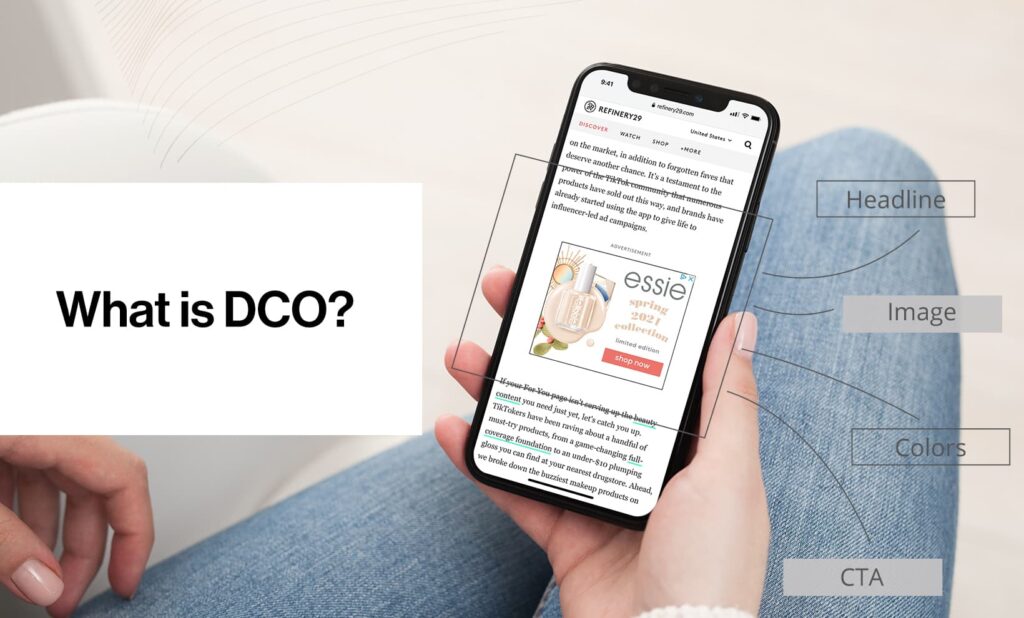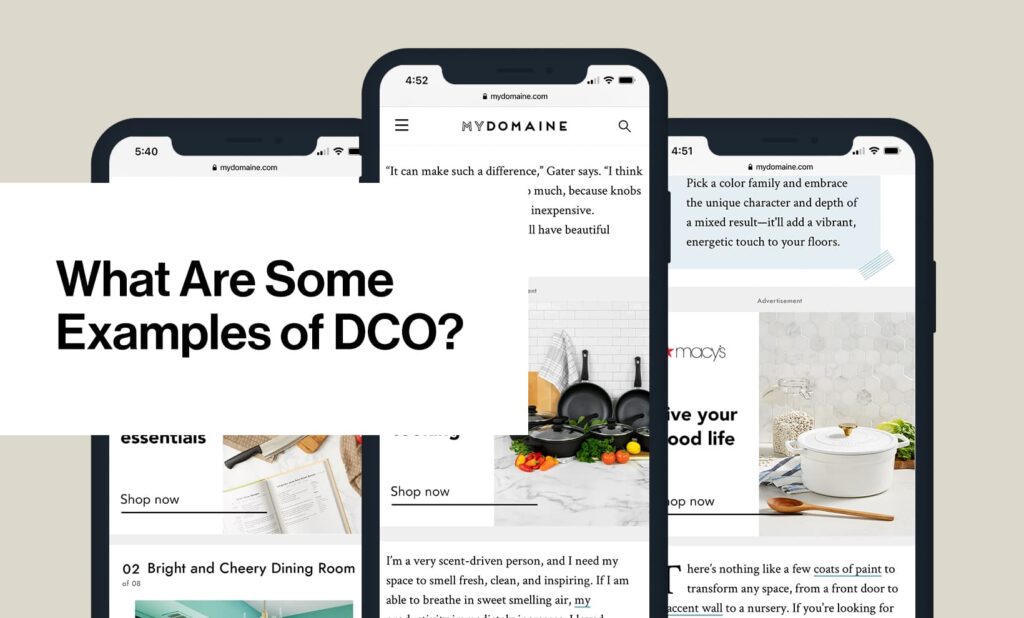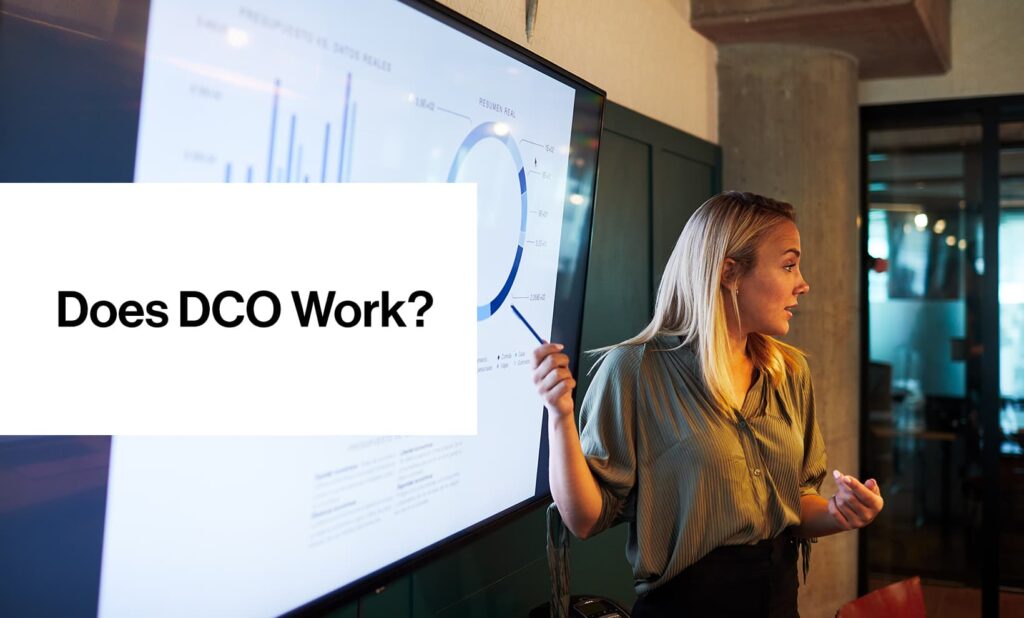Dynamic Creative Optimization, or DCO marketing, is a form of programmatic advertising that allows marketers to personalize the creative shown to individual audiences. Rather than displaying the same creative with the exact same words to every individual, DCO marketing relies on technology to match the best-suited ad creative to the user, based on criteria set up in advance by the marketer. In short, DCO is a display ad technology that creates personalized ads based on data collected about the viewer at the moment of ad serving. Through this personalization, the marketer is in effect matching the best content to the correct user, thereby optimizing the chances that the user likes what they see and is more likely to convert.
Table of Contents:
- What Is Dynamic Creative Optimization?
- Examples of Dynamic Creative Optimization
- Best Practices for Dynamic Creative Optimization
What Is What Is DCO Marketing?

Dynamic Creative Optimization generally starts with a template with a number of common elements that can be dynamically changed for each version. Virtually any component of an ad – the message, product features and benefits, pricing and imagery – can be changed in virtually unlimited combinations. The flexibility makes optimization and experimentation using DCO both cost-effective and rewarding from a performance perspective.
What Types of Campaigns Are Best Suited to DCO?

Given the fact that consumers enjoy personalization, virtually any kind of ad campaign can be optimized via DCO. Here are a few that work particularly well:
- Geo-targeted campaigns with localized information such as local promotions, products reflecting local tastes, as in the car dealership example above.
- Product-based campaigns targeting users who visit specific product pages and have shown purchase intent but have not yet converted. This offers an opportunity to retarget them with products they’ve seen. Abandoned shopping cart promotions, upsells, cross-sells, and down-sells are variants on this strategy.
- Demographic prospecting allows you to tailor each offer or message to specific demographics within your target audience.
- Behavioral prospecting targets audiences who are researching or interested in specific product categories and tailors the ad message, product, or offer to their interest.
- Contextual prospecting can tailor ads to page content for a more cohesive experience.
What Are Some Examples?

DCO can be simple or complicated, depending on the number of iterations you will be using for a particular campaign. Take for example a car dealership with 12 different locations in different cities. Each dealership has the same product offering, but they want to include the appropriate city, state, and contact information for the location that is closest to an individual who sees their ad. In that case, they would have 12 different versions of the same ad, and the AI that powers this dynamic creative optimization would ensure that the correct ad is shown to the correct person.
Another example at the more complicated end of the spectrum would be a jewelry retailer with hundreds or thousands of different products. Depending on the level of personalization the marketer is interested in, it is easy to see how thousands of products, each shown to specific audiences, could make the process of DCO cumbersome. But thanks to the artificial intelligence and machine learning that powers this programmatic technology, it is still possible to personalize at scale, in near real-time, with DCO.
Who Uses This Individualized Marketing?

Previously, dynamic creative optimization was a novel concept enjoyed only by the largest brands and agencies. Today, the technology is available to more advertisers than ever before, and many marketers are exploring how to utilize it to amplify the effectiveness of their campaigns.
If you run ads programmatically, either through an agency, a trading desk, or directly with a demand-side platform (DSP), you likely have the ability to deploy DCO.
Best Practices for Dynamic Creative Optimization (DCO)

Every day, more marketers test dynamic creative optimization for the first time. Whether those tests soar or falter depends on one important question: are marketers setting up their campaigns to succeed, or are they tethering their potential? To elevate the effectiveness of their efforts, there are 5 key best practices to consider when foraying into DCO.
Think Full Funnel
- DCO is more than a lower-funnel conversion tool. With DCO, marketers can craft full-funnel campaigns that optimize engagement at every stage of the customer journey. However, leveraging this requires implementing dynamic goals and rethinking KPIs for each phase of the funnel.
- Consider the customer journey and develop messaging iterations for each phase, from brand awareness through consideration, conversion, and advocacy.
Weave Unifying Threads
- When crafting messaging and visuals for each phase of the journey, don’t forget to weave unifying threads. As the AI will be determining the exact iteration that will be most effective for a given user at a given time, marketers cannot assume that users will see messages in a predictable sequence.
- With that in mind, take a step back and examine the creative elements across the campaign. Is the brand voice consistent whether the message is driving awareness or trying to drive a conversion? Are font choices and colors aligned? Are images consistent in composition? Could the pieces be shuffled, and would each ad sequence make sense?
Nurture the Feed
- Once the overarching theme and unifying visual threads have been woven, it’s time to nurture the feed itself. Each item should be carefully curated and optimized to perform within the context of the campaign and the templates chosen.
- In short, the feed should never be a direct export of a store’s top 100 selling products. Instead, the feed should contain carefully curated products with titles and descriptions that are edited to read cohesively when they appear next to one another.
- For instance, individual product names might be rather long, and available space for overlay text is limited. To avoid unfortunate truncation, carefully consider every character so that information is clear, concise, and compelling.
- Similarly, select product shots that utilize the majority of the frame when placed within the template’s container. Be mindful of any borders that are added via HTML to ensure adequate negative space.
Trust the AI
- With many DCO ad builders, it is often tempting to use a pre-built template that fits as many products as possible within the space. However, moderation is key.
- The strength of DCO lies in its ability to showcase the right message to the right user at the right time. This highly surgical tactic shouldn’t be treated with a scattershot approach wherein 4 or more products are crammed onto a single display banner. Trust in the AI’s ability to accurately select the best products to feature, and go with a template that is less busy and more compelling.
Leverage the Overlay
- Another way to create a more compelling DCO unit is to utilize the overlay. Typically, animated DCO units will include an overlay that appears at set intervals. Leverage this overlay smartly with a captivating & impactful visual.
- Don’t weigh overlays down with cluttered products or extraneous copy. A strong, unifying visual with a succinct message will help capture viewer attention, increasing engagement likelihood when the animation cycles back to dynamically optimized elements. It will also help in strengthening your unifying thread while aiding in upper-funnel brand awareness objectives.

Does DCO Work?
When marketers are thoughtful and strategic with DCO, the results are phenomenal. Across the board, advertisers we’ve guided through the DCO setup process have seen five to seven times higher engagement rates, significantly improving return on ad spend.
The results are a testament to the importance of using data to deliver the optimal message at the ideal time, at any phase of the customer journey. The key is in remembering that data and creative must serve as equal partners. When creativity is lost, so too is the potential of dynamically optimizing it.
Let’s Get Dynamic
Looking for help with your own dynamic creative optimization? AUDIENCEX runs thousands of cross-channel campaigns across every vertical, and our campaign strategists are on hand to answer any of your questions about DCO or digital advertising in general. Let’s chat.
Get the Guide: 5 Steps to Prepare for the Loss of Third-Party Cookies
In preparation for what’s to come, we’ve created a guide with 5 ways to plan your programmatic advertising strategy without the use of third-party cookies.
Fill out the form below to download the guide.

